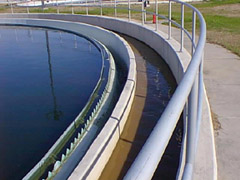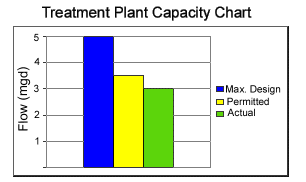
SCDES issues discharge permits (e.g., NPDES) for wastewater treatment plants. For domestic facilities, these permits are based on the facility design flow. For example, a plant that could treat 5 MGD (average) would reflect a design flow of 5 MGD.
At any given time, the actual flows at a plant would typically be less than its design capacity. Cities are constantly adding new collection systems to accommodate residential, commercial and industrial growth. For our hypothetical 5 MGD plant, it would not be surprising to see it flowing at 3 MGD on average. At this point, we have defined two concepts: Design flow and actual flow. To track true available capacity, SCDES identifies another concept: permitted capacity or obligated capacity.
Beyond actual flow, flow has been obligated via the issuance of new sewer collection system permits. The day SCDES issues such permits the flow has been obligated so SCDES accounts for this flow. For example, our 5 MGD plant may be flowing at 3 MGD, but permits have been issued for new collection systems that have yet to be fully utilized. In the case of a residential subdivision, even a couple of years after the permit has been issued, all of the lots may not have been built on and therefore the flow has yet to be fully realized. Therefore, it would be typical that the permitted flow to a treatment plant would be in between the actual flow and design capacity of the plant (see chart). In this example, the cumulative permitted flow is 3.5 MGD.
When do we stop permitting? SCDES issues sewer collection system permits until the permitted capacity (obligated flow) reaches the design capacity of the plant. At any time, a facility can provide data to SCDES to justify a revised permitting capacity (obligated flow) based on the circumstances in their community. Since the permitted/obligated flow is a prediction of future flow, those flows in reality may be higher or lower. Prior to that, SCDES may notify the plant owner when the permitted flow reaches 80% of the design capacity. In this notification, the utility is asked to submit a Preliminary Engineering Report (PER) to address their plans for additional capacity. This may be a trigger to reassess the permitted flows based on actual circumstances.

In some cases, the permitted flow can increase significantly higher than the actual flow which causes the Department's capacity tracking to become unreliable. The Department's Wastewater Capacity Adjustment Guidance is available to assist facilities with correcting the capacity tracking.
More Information? For more information on SCDES's program to track capacity in wastewater treatment facilities, please contact Kelly Whitlock at 803-898-3574.

